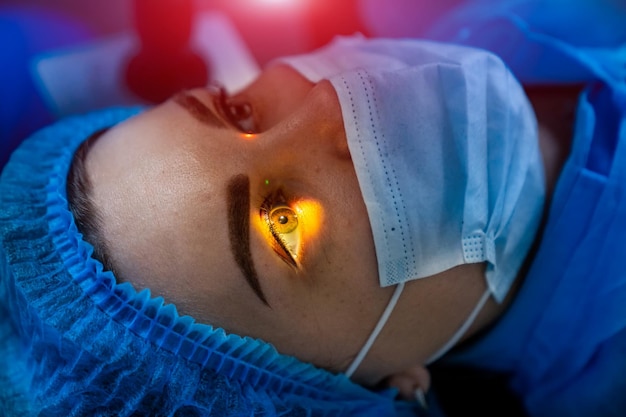Our eyes are valuable, and maintaining their well-being should be our priority. In today’s fast-paced world, we often neglect our eye health, leading to various vision problems. However, with a few simple practices and lifestyle changes, you can ensure a lifetime of clear vision and a bright future for your eyes.
Let’s explore the expert advice of renowned ophthalmologist Dr. Aarti Pandya MD, who shares her top tips for healthy eyes:

1. Regular Eye Exams
Dr. Pandya emphasizes the importance of regular eye exams as the foundation of eye health. These exams can detect potential problems early on, even before you notice any symptoms. It’s recommended to have a complete eye test every one to two years, depending on your age and risk factors. More frequent check-ups may be necessary for individuals with present eye conditions or a family history of eye diseases. Remember, early detection can often prevent or mitigate vision loss.
2. Maintain a Balanced Diet
A nutritious diet is important in maintaining healthy eyes. Dr. Pandya advises incorporating foods rich in antioxidants, vitamins, and minerals into your daily meals. Specifically, focus on:
- Vitamin A: Found in foods like carrots, sweet potatoes, and spinach, vitamin A is crucial for good vision and preventing night blindness.
- Omega-3 Fatty Acids: Foods like salmon, walnuts, and flaxseeds are rich in these essential fatty acids, which can help decrease the risk of dry eyes and macular degeneration.
- Lutein and Zeaxanthin: These antioxidants are found in kale, broccoli, and egg yolks and can help protect the eyes from dangerous light and reduce the risk of cataracts.
3. Protect Your Eyes from UV Radiation
Prolonged exposure to UV rays can damage your eyes and raise the possibility of cataracts and other eye conditions. Dr. Pandya recommends wearing sunglasses that block 100% of UVA and UVB rays whenever you’re outside, even on cloudy days. Additionally, wearing a wide-brimmed hat can provide extra protection to your eyes and the delicate skin around them.
4. Give Your Eyes a Pause from Screens
In today’s digital age, we spend a significant portion of our day staring at screens – be it computers, smartphones, or tablets. This prolonged screen time can lead to digital eye stress, also known as computer vision syndrome. To alleviate this, Dr. Pandya suggests practicing the 20-20-20 rule: After every 20 minutes, take a 20-second pause and look at something 20 feet away. Blinking frequently and using artificial tears can also help keep your eyes moist and comfortable during extended screen use.
5. Proper Lighting and Ergonomics
Creating an eye-friendly workspace is crucial for preventing eye strain. Dr. Pandya advises positioning your computer screen at eye level so you don’t have to tilt your head up or down. Proper lighting is essential, too – avoid glare on your screen and ensure that your workspace is well-lit. Adjusting font size and screen brightness can also reduce eye strain.
6. Stay Hydrated
Dehydration can make dry eyes, which can be uncomfortable and potentially harm your vision. Dr. Pandya recommends drinking plenty of water throughout the day to keep your body and eyes hydrated. The dry air can exacerbate dry eye symptoms if you spend a lot of time in air-conditioned or heated environments. Using a humidifier can help maintain an appropriate humidity level in indoor spaces.
7. Get Quality Sleep
A good night’s sleep is not only essential for your overall well-being but also for your eye health. Dr. Pandya emphasizes that your eyes rest, repair, and regenerate during sleep. Lack of sleep can cause eye dryness and fatigue. Aim for 7-8 hours of excellent sleep each night to ensure your eyes are adequately rejuvenated.
8. Don’t Smoke, and Limit Alcohol
Smoking is risky to each aspect of your health, including your eyes. It increases the threat of cataracts, macular degeneration, and dry eyes. If you’re a smoker, quitting is one of the best things you can do for your overall health and your eyes. Additionally, extreme alcohol consumption can result in vision problems. Moderation is important when it comes to alcohol intake.
9. Manage Chronic Health Conditions
Several chronic health conditions, such as diabetes and hypertension, can have a significant impact on your eye health. Dr. Pandya advises managing these conditions through regular medical check-ups and following your healthcare provider’s recommendations. Properly managing chronic illnesses can help prevent complications that may affect your eyes.
10. Practice Good Hygiene
Maintaining good eye hygiene can prevent infections and eye irritations. Dr. Pandya recommends:
- Washing Your Hands: Always wash your hands thoroughly before touching your eyes or using contact lenses.
- Proper Contact Lens Care: If you wear contact lenses, follow the care instructions meticulously and avoid sleeping in them unless your eye doctor advises.
- Avoid Rubbing Your Eyes: Rubbing your eyes can introduce dirt and bacteria, leading to infections or corneal abrasions.
11. Stay Active
Regular physical activity promotes overall health, including good circulation, which is important for your eyes. Dr. Pandya suggests incorporating regular exercise into your routine to help prevent conditions like glaucoma and age-related macular degeneration. However, be sure to protect your eyes during sports or activities that could lead to eye injuries by wearing appropriate protective gear.
12. Be Mindful of Eye Allergies
Eye allergies can be bothersome and affect your eye health. Dr. Pandya advises identifying your allergy triggers and taking steps to minimize exposure. Over-the-counter or prescription antihistamine eye drops can provide relief but consult with an eye specialist for personalized recommendations.
Conclusion
Your eyes are irreplaceable, and maintaining their health should be a priority. By following Dr. Aarti Pandya‘s expert advice, you can take significant steps towards ensuring a lifetime of clear vision and a bright future for your eyes. Remember, a combination of regular eye exams, a balanced diet, UV protection, and lifestyle adjustments can go a long way in preserving your precious gift of sight. Don’t wait until problems arise; start caring for your eyes today for a clearer, brighter tomorrow.





